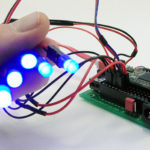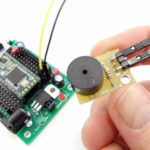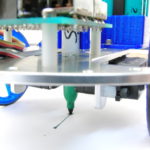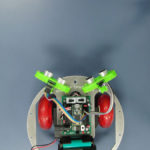In 2002, I started creating the Physical Computing & Robotics (PCR) Curriculum for high school, college, and university courses. Back then, robotics was only for hobbyists and a few high-end university programs. Even today, most high schools only offer physical computing experiences such as robotics as after-school programs or clubs. And even worse, students often have to take turns working on a single robot. I love it when students collaborate, but I think it is imperative that students have experience coding and building their own robot, especially in the early stages of their education. My curriculum and the Patton Robotics robots offer educational robotics that are so affordable that every student can have their robot with which to experiment.
I am a former rocket scientist who has been programming computers since 1982. Until very recently, I was frustrated by how difficult it was to integrate the motors, lights, buzzers, sensors, relays, and actuators of the real world with the digital world of computers. All that changed with the advent of inexpensive microcontrollers or embedded controllers. With these handy devices, it is now simple (and commonplace) to control those real world devices with easy-to-understand code.
My PCR Curriculum is found in two textbooks, totaling 866 pages. (You can buy them here: www.lulu.com/spotlight/ChrisOdom.) The curriculum starts at the very beginning for the complete novice. It then builds on that foundation with hundreds of easy-to-follow, logical, and fully explained examples. But it is more than a beginner’s primer. My curriculum then takes you as deep as you want to go with sophisticated algorithms and in-depth explanations of not only how to write code, read sensors, and control actuators, but why it works.
In other words, by following my curriculum, a complete novice will have the skills and knowledge to create just about any type of robotics or embedded controller application from scratch. I can say this with certainty, because over the past 16 years, nearly 450 of my own students have completed my curriculum, and less than 10% of them have any experience with programming, robotics, or electronics.
However, my curriculum is not merely for the uninitiated novice. While it does start at the beginning with the standard “Hello World” application, the PCR Curriculum takes you as deep as you want to go. Middle schoolers will use less of the curriculum than high school students will, and they are likely not to cover as much of the textbooks as university students. My textbooks are currently being used in high school and college classrooms around the world such as St. Andrews Episcopal School in Mississippi, Millersville University in Pennsylvania, and Princeton University in New Jersey.
And when I say my students “follow” my curriculum, I mean it. I do not lecture; my students read my books and answer the assigned Challenge Problems at their own pace. I am around to answer their questions and help debug their code, but they teach themselves using only my textbooks.
During the last 8-10 weeks of my introductory course, those same novices are required to create their own robotic or embedded controller application from scratch and present it to the public during our Robotics Open House. You can see some of my introductory students’ final projects here:
- 2017-18 { Student Projects }
- 2016-17 { Student Projects }
- 2015-16 { Open House Teaser Video | Student Projects }
- 2014-15 { Open House Teaser Video | Student Projects }
- 2013-14 { Student Projects }
- 2012-13 { Open House Teaser Video | Student Projects }
- 2011-12 { Student Projects }
- 2010-11 { Student Projects }
- 2009-10 { Student Projects }
The Inspiration of Kylan Turner
Read about Kylan Turner, who was one of my first robotics students at George School. Kylan was inspirational nucleus of the robotics program at GS. Read her story here: Kylan_Turner_Georgian05.pdf }
About the Author:

A former atmospheric physicist and rocket scientist, Chris D. Odom started writing computer code as a seventh-grader in 1982. Since then, programming computers and embedded controllers has been an integral part of his academic and professional life. His computer applications were an essential part of his Bachelor’s, Master’s, and PhD work in experimental physics, and his early forays into physical computing included building homemade oscilloscopes and data acquisition systems for NASA sounding rocket payloads. Even though he is excited about science and technology, Chris’ passion lies in education, and he has taught at nearly every level, including middle school, high school, technical college, and research university. He is the author of multiple textbooks in the fields of physical computing, robotics, and physics, and he has developed numerous online tutorials in programming, robotics, and CAD design. He and his wife, Kathleen, live and work at George School in Newtown, PA. They have two daughters, Ivy and Josie.



